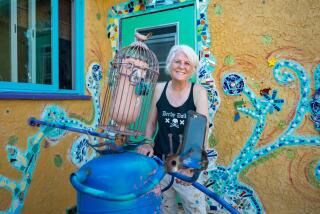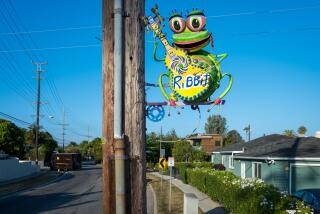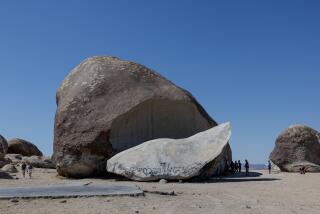Port Chief Hurls Rocks From Exxon Valdez Into Fray Over Bayfront Art
After years of debating what kind of art belongs alongside San Diego Bay, Louis Wolfsheimer wonders if the answer might be right under the port commissionersâ seven noses.
Wolfsheimer, the San Diego Unified Port District board chairman, isnât sure how to put a price on the two Volkswagen-sized boulders that were recently extracted from the damaged hull of the Exxon Valdez. But pound for pound or ton for ton, he said Monday, the district would likely pay Exxon Shipping Co. a tidy sum for the chance to make one of the rocks into what he calls an âenvironmental monument.â
âEvery time our people come up with a piece of art, the commission says itâs too avant-garde,â Wolfsheimer said, noting that the district has more than $1.5 million set aside for public art expenditures, but has rejected most proposals. âI think a boulder in its natural state might work, even with a little oil on it.â
Wolfsheimerâs whimsical proposal would secure a final resting place for one of the rocks, which became embedded in the Valdezâs steel hull March 24 when the ship ran aground off Alaska. But Exxon Shipping Co. officials, who are facing extensive litigation over the largest oil spill in U.S. history, say they arenât selling.
âAs far as I know, itâs not for sale,â said Les Rogers, an Exxon Shipping Co. spokesman, who said he knew of no plans to put either the 6-ton or the 10-ton boulder on display. âI wouldnât see any particular advantage to the company in doing that. Exxon intends to maintain possession until litigation is over, years down the road. Then, who knows.â
Exxonâs resistance to making the boulders available is consistent with the Port Districtâs foiled attempts to buy public
art. Last year, the Port Districtâs arts advisory committee, a six-member, blue-ribbon panel, resigned en masse. Their gripe: in four years, the advisory committee had recommended three artworks, all of which the port commissioners either rejected or revised so drastically that the artist withdrew.
In the meantime, the Port District accepted two sculptures without its art committeeâs help. Hugh Davis, director of the La Jolla Museum of Contemporary Art and a former member of the arts committee, called one of the pieces, a bronze casting of Charles Lindbergh, a âgratuitous piece of kitsch.â
By offering to mount the boulder on a pedestal, Wolfsheimer said, he meant no affront to the art world. And, to environmentalists like Rick Nadeau of Greenpeace Action, who said he chafes at the idea of turning the Exxon Valdez into a tourist attraction, Wolfsheimer responded: âIt was supposed to be fun, educational, historical--a way to remind people what can happen when youâre not careful.â
For his part, Wolfsheimer questioned how Exxon can claim ownership of what he calls âthe most famous boulders in the last century,â which are being stored in locked steel boxes at the National Steel & Shipbuilding Co., where the Valdez was built and now is being repaired.
âI canât imagine how they own it,â he said. âThe Exxon Valdez was built in San Diego, it is being repaired in San Diego--thereâs a great connection between San Diego and the ship. If we donât get (the boulder), it should be placed in Alaska, where the Valdez picked it up.â
Wolfsheimer imagines that, if the Port District paid, say, $50,000 for a massive piece of history, the money could go toward cleanup of the spill. But, if Exxon wonât part with it, he said, heâs not going to fight.
âThis isnât my lifeâs work,â he said. âThereâs a lot of things we have to accomplish at the port, and one of them is not suing Exxon.â
More to Read
Sign up for Essential California
The most important California stories and recommendations in your inbox every morning.
You may occasionally receive promotional content from the Los Angeles Times.










